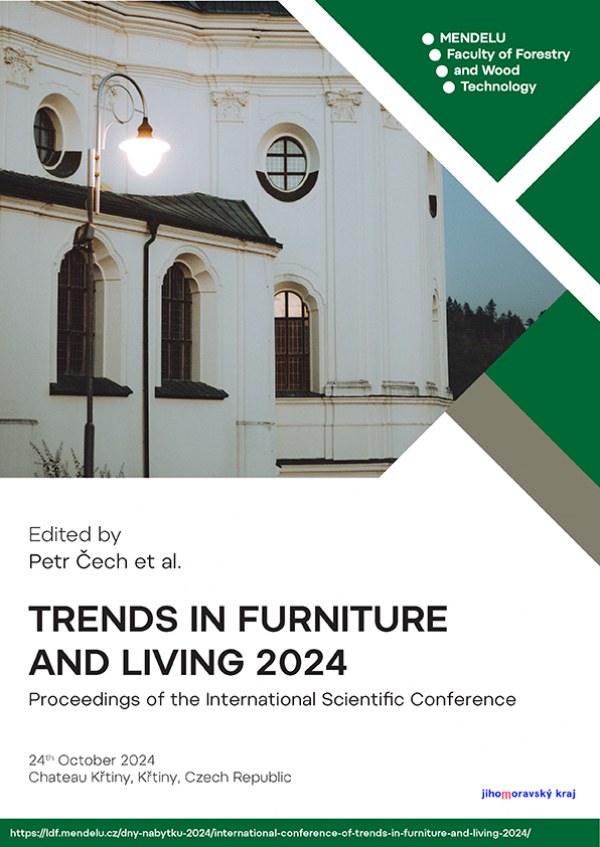
DOI: 10.11118/978-80-7701-044-3-0050
JOINING SOLID WOOD WITH EPOXY RESINS
- Petr Pacas1, Daniela Tesařová1
- 1 Ústav designu a nábytku, Lesnická a dřevařská fakulta, Mendelova univerzita v Brně, Zemědělská 1, 613 00 Brno, Czech Republic
The paper deals with the analysis of the suitability of selected woods (acacia, oak, meranti) for bonding with casting epoxy resin. The main objective is to evaluate the influence of the thickness of the cast joint on the strength properties of the formed joints. The investigated wood species differ in their physical and mechanical properties, which can significantly affect the resulting cohesion and strength of the joint. In addition to the interaction between the wood and the epoxy resin itself, the cohesive strength of the cured resin, which plays an important role in the mechanical behaviour of the joint, was also investigated. The experiments focused on measuring the strength at different cast joint thicknesses, which provided valuable information on the optimum parameters for joint formation. The results of this study provide new insights for the structural and design applications of epoxy resins in conjunction with natural materials such as wood and contribute to the development of efficient methods for producing strong and reliable joints.
Keywords: casting epoxy resin, joint width, shear strength, tensile load, impact strength, acacia, oak, meranti
pages: 50-54, online: 2025
References
- LIDAŘÍK, M. 1983. Epoxidové pryskyřice. 3rd Editon. Praha: SNTL, Makromolekulární látky.
- MLEZIVA, J. 1993. Polymery - výroba, struktura, vlastnosti a použití. Praha: Sobotáles. ISBN 80-901570-4-1
- PHAM, H. Q.; MARKS, M. J. 2002. Epoxy Resins. In: HERMAN, M. F. (Ed.). Encylopedia of Polymer Science and Technology. John Wiley & Sons. ISBN 9781118633892
- DOMINIGHAUS, H. 1993. Plastics for engineers: Material, Properties, Applications. Munich: Hansen Publisher. ISBN 344615239
- RYBNIKÁŘ, F. 2000. Makromolekulární chemie. Brno: VUT v Brně. ISBN 80-214-1556-8
- PROKOPOVÁ, I. 2007. Makromolekulární chemie. 2nd Edition. Praha: Vydavatelství VŠCHT. ISBN 978-807-0806-623
- KALENDOVÁ, A.; TAMCHYNOVÁ, P. 2003. Studium nátěrových systémů pro korozní ochranu kovových materiálů z hlediska výběru pojiv a pigmentů. CHEMagazín. XIII, 28-31.
- LIU, Z; KRAUS, G. 2015. Green Materials from Plant Oils. Royal Society of Chemistry. ISBN 978-1-84973-901-6
- JIN, F.-L.; LI, X.; PARK, S.-J. 2015. Synthesis and application of epoxy resins: A review. Journal of Industrial and Engineering Chemistry. 29, 1-11. ISSN 1226-086X. https://doi.org/10.1016/j.jiec.2015.03.026
 Go to original source...
Go to original source... - KUBEŠ, T. 2020. Možnosti modifikace epoxidové směsi nanometrickým plnivem. Diploma Thesis. Plzeň: Západočeská univerzita v Plzni, Fakulta elektrotechnická.
- MOHAN, P. 2013. A Critical Review: The Modification, Properties, and Applications of Epoxy Resins. Polymer-Plastics Technology and Engineering. 52(2), 107-125. https://doi.org/10.1080/03602559.2012.727057
 Go to original source...
Go to original source... - BARTOLI, M.; DURACCIO, D.; FAGA, M.; PIATTI, E.; TORSELLO, D.; GHIGO, G.; MALUCELLI, G. 2022. Mechanical, electrical, thermal and tribological behavior of epoxy resin composites reinforced with waste hemp-derived carbon fibers. Journal of Materials Science. 57, 14861-14876. https://doi.org/10.1007/s10853-022-07550-9
 Go to original source...
Go to original source... - SZEWCZAK, A., SZELĄG, M. 2019. Modifications of Epoxy Resins and their Influence on their Viscosity. IOP Conf. Ser.: Mater. Sci. Eng. 471(2), 022038.
 Go to original source...
Go to original source... - PACAS, P. 2022. Vliv střídání klimatických podmínek a mechanického namáhání na pevnostní vlastnosti spojů licích pryskyřic a masivního dřeva. Diploma Thesis. Brno: Mendelova univerzita v Brně, Lesnická a dřevařská fakulta.
- ČSN EN 1465. 1997. Lepidla - Stanovení pevnosti ve smyku při tahovém namáhání přeplátovaných lepených sestav. Česká agentura pro standartizaci.
- ČSN EN 322. 1994. Dosky z dreva. Zisťovanie vlhkosti.


